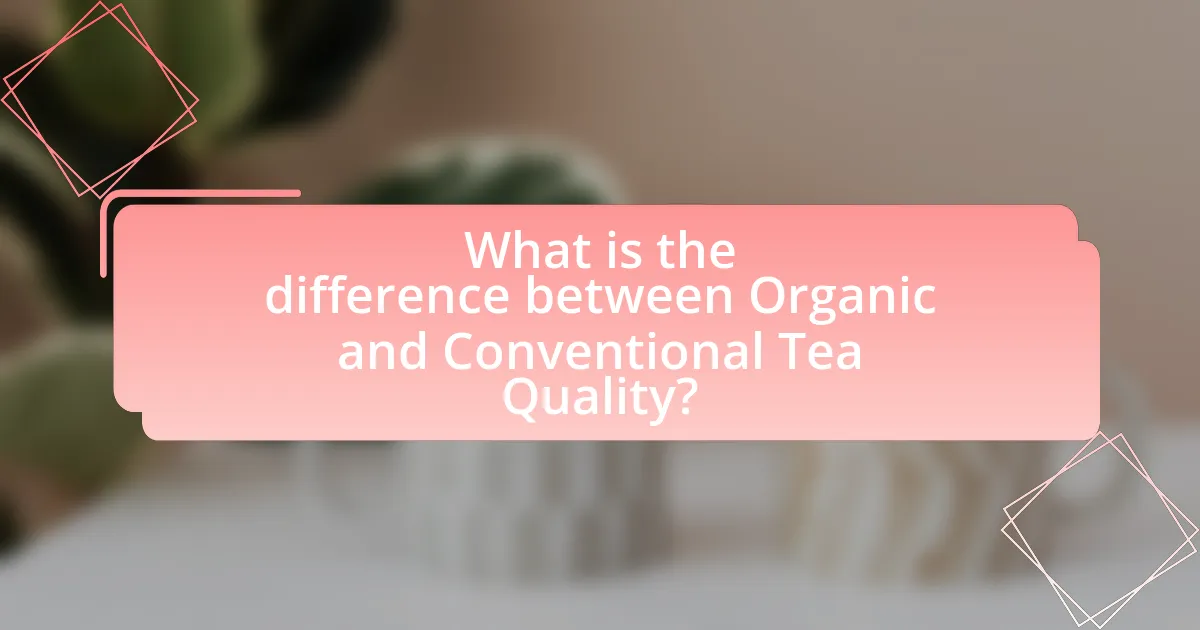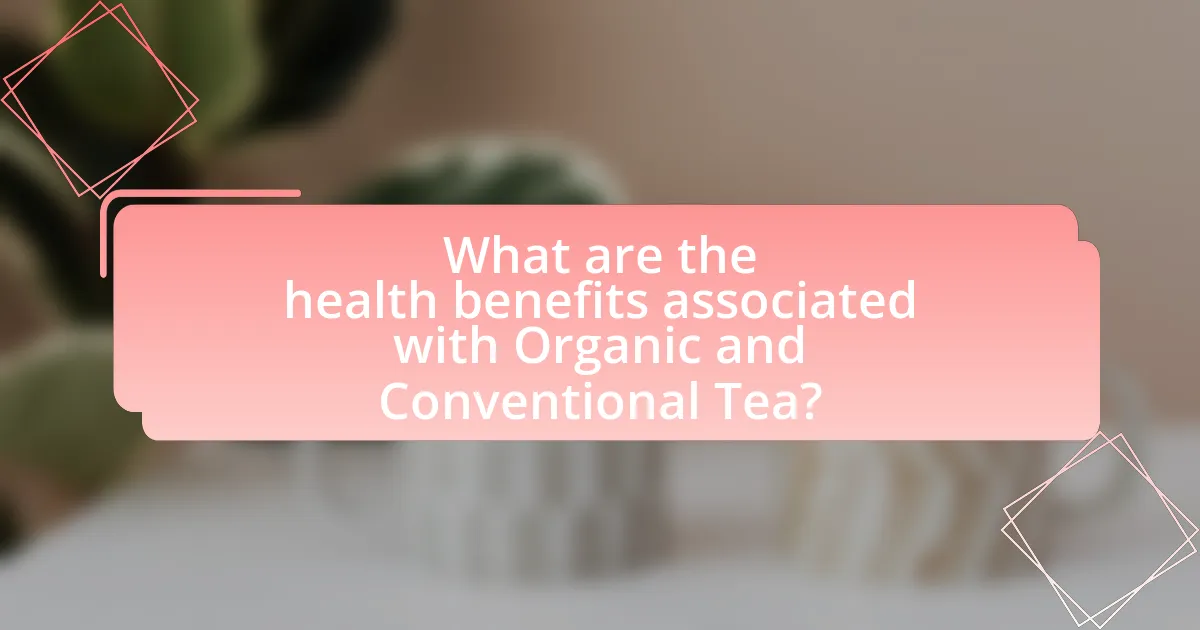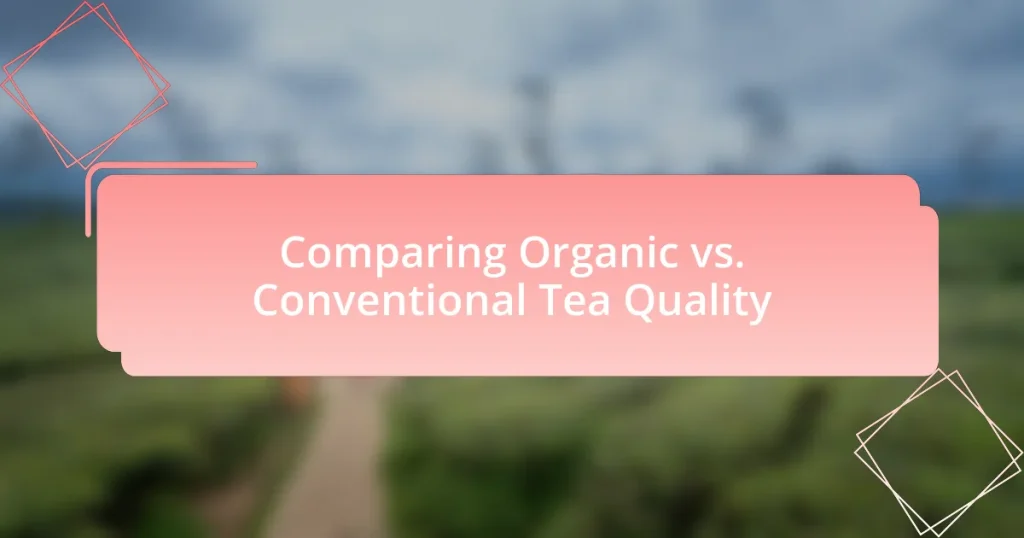The article focuses on comparing the quality of organic and conventional tea, highlighting the differences in cultivation practices, health benefits, and sensory attributes. Organic tea is characterized by its adherence to strict agricultural standards that prohibit synthetic pesticides and fertilizers, resulting in superior flavor, aroma, and higher antioxidant levels. In contrast, conventional tea often relies on chemical inputs that can affect taste and may leave pesticide residues. The article also discusses the implications of these differences for consumer health, market trends, and practical tips for selecting high-quality tea.

What is the difference between Organic and Conventional Tea Quality?
Organic tea quality is generally considered superior to conventional tea quality due to the absence of synthetic pesticides and fertilizers in its cultivation. Organic tea is grown using natural methods that promote biodiversity and soil health, which can enhance flavor and aroma. In contrast, conventional tea often relies on chemical inputs that may affect the taste and overall quality of the final product. Studies have shown that organic teas can contain higher levels of antioxidants, which contribute to health benefits, further supporting the perception of higher quality.
How is Organic Tea defined in terms of quality?
Organic tea is defined in terms of quality by its adherence to strict agricultural standards that prohibit synthetic pesticides, herbicides, and fertilizers. This commitment to natural farming practices not only enhances the flavor profile and aroma of the tea but also ensures higher levels of antioxidants and beneficial compounds, such as polyphenols. Research indicates that organic tea can contain up to 30% more antioxidants compared to conventional tea, contributing to its superior health benefits. Additionally, organic certification requires rigorous testing and compliance with regulations, which further validates the quality of the product.
What standards must Organic Tea meet for quality certification?
Organic tea must meet specific standards set by certifying bodies such as the USDA or EU Organic regulations to achieve quality certification. These standards include the prohibition of synthetic pesticides and fertilizers, the requirement for organic farming practices that promote biodiversity and soil health, and adherence to strict guidelines for processing and handling to prevent contamination with non-organic substances. For instance, the USDA requires that at least 95% of the ingredients in a product labeled as organic must be organic, ensuring that consumers receive a product that aligns with organic farming principles.
How does the cultivation process of Organic Tea impact its quality?
The cultivation process of Organic Tea significantly enhances its quality by promoting the use of natural fertilizers and pest control methods, which leads to healthier tea plants. Organic farming practices, such as crop rotation and composting, improve soil health and biodiversity, resulting in richer flavors and higher antioxidant levels in the tea leaves. Studies have shown that organic tea contains higher concentrations of polyphenols, which are beneficial for health, compared to conventionally grown tea. For instance, research published in the Journal of Agricultural and Food Chemistry found that organic tea had up to 30% more catechins, a type of antioxidant, than its conventional counterparts. This evidence underscores the positive impact of organic cultivation methods on the overall quality of tea.
What defines Conventional Tea quality?
Conventional tea quality is defined by factors such as leaf appearance, aroma, flavor, and the absence of defects. High-quality conventional tea typically features uniform, whole leaves that are free from stems and dust, indicating careful processing. The aroma should be fresh and inviting, while the flavor must be balanced, with a pleasant aftertaste. Additionally, conventional tea is often assessed for its chemical composition, including caffeine and polyphenol levels, which can influence taste and health benefits. Studies have shown that conventional teas may contain higher pesticide residues compared to organic teas, impacting overall quality perception among consumers.
What agricultural practices are commonly used in Conventional Tea production?
Conventional tea production commonly employs practices such as the use of synthetic fertilizers, pesticides, and herbicides to enhance yield and control pests. These practices are aimed at maximizing production efficiency and ensuring the quality of the tea leaves. For instance, synthetic fertilizers provide essential nutrients like nitrogen, phosphorus, and potassium, which are crucial for plant growth and development. Additionally, the application of chemical pesticides helps in managing insect infestations and diseases that can adversely affect tea crops. Research indicates that these methods can lead to higher yields compared to organic practices, as they allow for more controlled growth conditions and reduced crop loss.
How do these practices affect the quality of Conventional Tea?
Conventional tea quality is significantly affected by agricultural practices such as the use of synthetic fertilizers and pesticides. These practices can lead to higher yields and quicker growth, but they may also result in lower flavor complexity and potential chemical residues in the final product. Research indicates that conventional tea often contains higher levels of pesticide residues compared to organic tea, which can impact consumer safety and perception of quality. Additionally, the reliance on chemical inputs can diminish soil health over time, ultimately affecting the long-term sustainability and quality of tea production.
Why is it important to compare the quality of Organic and Conventional Tea?
Comparing the quality of Organic and Conventional Tea is important because it helps consumers make informed choices regarding health, environmental impact, and taste preferences. Organic tea is grown without synthetic pesticides and fertilizers, which can lead to higher levels of beneficial compounds such as antioxidants. Studies, such as one published in the Journal of Agricultural and Food Chemistry, have shown that organic teas often contain higher concentrations of polyphenols, which are linked to various health benefits. In contrast, conventional tea may have residues from chemical treatments that could affect both health and flavor. Therefore, understanding these differences is crucial for consumers who prioritize health and sustainability in their purchasing decisions.
What health implications are associated with the consumption of Organic vs. Conventional Tea?
The health implications associated with the consumption of organic tea versus conventional tea primarily revolve around pesticide exposure and antioxidant levels. Organic tea is grown without synthetic pesticides and fertilizers, which reduces the risk of chemical residues in the final product. Studies indicate that organic tea may contain higher levels of antioxidants, such as catechins, which are beneficial for health due to their potential to reduce inflammation and lower the risk of chronic diseases. In contrast, conventional tea may have pesticide residues that could pose health risks, including potential endocrine disruption and other toxic effects. Research published in the Journal of Agricultural and Food Chemistry found that organic teas had significantly lower pesticide levels compared to their conventional counterparts, reinforcing the health benefits of choosing organic options.
How do consumer preferences influence the market for Organic and Conventional Tea?
Consumer preferences significantly influence the market for Organic and Conventional Tea by driving demand towards organic options due to perceived health benefits and environmental concerns. A 2021 survey indicated that 70% of consumers prefer organic tea because they associate it with higher quality and safety, leading to increased sales in the organic segment. This shift in preference has prompted conventional tea producers to adapt their offerings, often incorporating organic practices to meet consumer expectations. Consequently, the market dynamics reflect a growing trend towards organic tea, with sales of organic tea increasing by 20% annually, while conventional tea sales have stagnated.

What are the sensory differences between Organic and Conventional Tea?
Organic tea typically exhibits a more complex flavor profile and aroma compared to conventional tea. This difference arises from the absence of synthetic pesticides and fertilizers in organic farming, which allows for a more diverse ecosystem and healthier soil, contributing to richer taste and scent. Studies have shown that organic teas often contain higher levels of antioxidants and essential oils, enhancing their sensory attributes. For instance, a study published in the Journal of Agricultural and Food Chemistry found that organic teas had significantly higher concentrations of polyphenols, which are responsible for flavor and health benefits, compared to their conventional counterparts.
How do taste profiles differ between Organic and Conventional Tea?
Organic tea typically has a more complex and nuanced flavor profile compared to conventional tea. This difference arises from the absence of synthetic pesticides and fertilizers in organic farming, which allows the natural flavors of the tea leaves to develop more fully. Studies have shown that organic teas often exhibit higher levels of certain beneficial compounds, such as polyphenols and flavonoids, which contribute to a richer taste and aroma. For instance, research published in the Journal of Agricultural and Food Chemistry indicates that organic teas can have up to 30% more antioxidants than their conventional counterparts, enhancing their flavor complexity.
What factors contribute to the flavor differences in Organic Tea?
Flavor differences in organic tea are primarily influenced by cultivation practices, soil quality, and processing methods. Organic tea is grown without synthetic pesticides or fertilizers, which can lead to a more diverse microbial ecosystem in the soil, enhancing the flavor profile of the tea leaves. Additionally, the use of natural fertilizers, such as compost, contributes to the nutrient content of the soil, affecting the taste. The timing of harvest and the specific tea cultivar also play significant roles; for instance, leaves picked at optimal maturity tend to have richer flavors. Processing methods, including drying and fermentation, further influence flavor development, as traditional methods often preserve the natural characteristics of the tea. Studies have shown that organic teas can exhibit higher levels of certain flavor compounds, such as polyphenols and amino acids, which contribute to a more complex taste experience.
How does the processing of Conventional Tea affect its taste?
The processing of Conventional Tea significantly affects its taste by determining the oxidation level, flavor compounds, and aroma. Conventional tea undergoes various processing steps, including withering, rolling, oxidation, and drying, which influence its final flavor profile. For instance, black tea, a common type of conventional tea, is fully oxidized, resulting in a robust and malty flavor, while green tea is minimally oxidized, preserving a more delicate and grassy taste. Research indicates that the specific methods used in processing, such as the duration of oxidation and the temperature during drying, can enhance or diminish certain flavor notes, ultimately shaping the overall sensory experience of the tea.
What aroma characteristics can be observed in Organic vs. Conventional Tea?
Organic tea typically exhibits more complex and nuanced aroma characteristics compared to conventional tea. This complexity arises from the absence of synthetic pesticides and fertilizers in organic farming, which allows for a richer development of natural compounds. Studies have shown that organic teas often have higher concentrations of volatile compounds, such as terpenes and phenolic compounds, contributing to a more vibrant and diverse aroma profile. For instance, research published in the Journal of Agricultural and Food Chemistry indicates that organic teas can contain up to 30% more aromatic compounds than their conventional counterparts, enhancing their overall sensory experience.
How does the growing environment influence the aroma of Organic Tea?
The growing environment significantly influences the aroma of organic tea by affecting the chemical composition of the tea leaves. Factors such as soil quality, altitude, climate, and cultivation practices contribute to the development of volatile compounds responsible for aroma. For instance, tea grown in nutrient-rich, well-drained soil tends to produce leaves with higher concentrations of aromatic compounds like linalool and geraniol, which enhance the fragrance. Additionally, higher altitudes often result in slower leaf growth, allowing for more complex flavor profiles and aromas due to increased exposure to sunlight and cooler temperatures. Research indicates that organic farming practices, which avoid synthetic fertilizers and pesticides, can lead to a more diverse microbial ecosystem in the soil, further enriching the aroma profile of the tea.
What role does processing play in the aroma of Conventional Tea?
Processing plays a crucial role in the aroma of Conventional Tea by influencing the chemical composition of the leaves. The methods of withering, rolling, oxidation, and drying during processing significantly affect the volatile compounds responsible for aroma. For instance, oxidation enhances the formation of aromatic compounds such as catechins and polyphenols, which contribute to the tea’s fragrance. Studies have shown that different processing techniques can lead to variations in aroma profiles; for example, black tea undergoes full oxidation, resulting in a robust aroma, while green tea is minimally processed, preserving a more delicate scent. This relationship between processing and aroma is well-documented in tea research, highlighting how specific techniques directly impact the sensory qualities of Conventional Tea.
How does the appearance of Organic and Conventional Tea differ?
Organic tea typically appears more vibrant and varied in color, with leaves that may show a range of greens and browns, reflecting the natural growing conditions and lack of synthetic fertilizers or pesticides. In contrast, conventional tea often has a more uniform appearance, with leaves that may appear darker or more processed due to the use of chemical treatments and additives. This difference in appearance is a direct result of the cultivation methods, where organic practices promote biodiversity and natural growth, while conventional methods prioritize yield and consistency.
What visual indicators can help identify high-quality Organic Tea?
High-quality Organic Tea can be identified by its vibrant color, whole leaves, and a lack of dust or broken particles. The vibrant color indicates freshness and proper processing, while whole leaves suggest careful handling and minimal processing, which preserves flavor and nutrients. Additionally, the absence of dust or broken particles signifies that the tea has been sorted and graded effectively, ensuring a premium product. These visual indicators are essential for discerning the quality of Organic Tea, as they reflect the cultivation and processing standards that are characteristic of organic practices.
How can the appearance of Conventional Tea indicate its quality level?
The appearance of Conventional Tea can indicate its quality level through characteristics such as leaf size, color, and uniformity. High-quality conventional tea typically features whole, unbroken leaves that are vibrant in color, indicating proper processing and freshness. For instance, a rich green or deep brown color suggests optimal oxidation and drying processes, while dull or faded leaves may indicate age or poor handling. Additionally, uniformity in leaf size and shape reflects careful harvesting and sorting, which are hallmarks of higher quality. Studies have shown that visual attributes correlate with flavor and aroma, further supporting the link between appearance and quality in tea.

What are the health benefits associated with Organic and Conventional Tea?
Organic and conventional tea both offer health benefits, but they differ in certain aspects. Organic tea is often higher in antioxidants, which can help reduce inflammation and lower the risk of chronic diseases. Studies indicate that organic tea contains fewer pesticide residues, making it a safer choice for consumers concerned about chemical exposure. Conventional tea, while still beneficial, may have higher levels of certain contaminants due to agricultural practices. Both types of tea can improve heart health, enhance mental alertness, and provide hydration, but the organic variety is generally preferred for its purity and higher antioxidant content.
What nutritional differences exist between Organic and Conventional Tea?
Organic tea typically contains higher levels of antioxidants and polyphenols compared to conventional tea. Studies have shown that organic farming practices, which avoid synthetic pesticides and fertilizers, can enhance the nutritional profile of tea leaves. For instance, a study published in the Journal of Agricultural and Food Chemistry found that organic teas had significantly higher concentrations of catechins, a type of antioxidant, than their conventional counterparts. Additionally, organic tea may have lower levels of harmful residues, contributing to a cleaner nutritional profile.
How do pesticide residues in Conventional Tea affect its nutritional value?
Pesticide residues in conventional tea can negatively affect its nutritional value by potentially reducing the levels of beneficial compounds such as antioxidants and vitamins. Studies have shown that certain pesticides can interfere with the metabolic processes of tea plants, leading to a decrease in the synthesis of these important nutrients. For instance, research published in the Journal of Agricultural and Food Chemistry indicates that pesticide exposure can alter the phenolic content in tea leaves, which are crucial for their health benefits. This alteration can diminish the overall quality and nutritional profile of conventional tea compared to organic alternatives, which typically have lower pesticide residues and higher concentrations of beneficial compounds.
What beneficial compounds are more prevalent in Organic Tea?
Organic tea is more prevalent in beneficial compounds such as polyphenols, catechins, and flavonoids. These compounds are known for their antioxidant properties, which help in reducing oxidative stress and inflammation in the body. Research indicates that organic tea often contains higher levels of these compounds due to the absence of synthetic pesticides and fertilizers, which can affect the plant’s natural growth and compound production. A study published in the Journal of Agricultural and Food Chemistry found that organic tea had significantly higher concentrations of catechins compared to conventional tea, reinforcing the notion that organic cultivation methods enhance the nutritional profile of tea.
How do the health benefits of Organic Tea compare to those of Conventional Tea?
Organic tea generally offers greater health benefits compared to conventional tea due to its higher levels of antioxidants and lower pesticide residues. Studies indicate that organic tea contains more polyphenols, which are beneficial for heart health and may reduce the risk of chronic diseases. For instance, research published in the Journal of Agricultural and Food Chemistry found that organic green tea had significantly higher antioxidant activity than its conventional counterpart. Additionally, organic tea is produced without synthetic pesticides, which can lead to lower exposure to harmful chemicals, further enhancing its health profile.
What studies support the health claims of Organic Tea?
Studies supporting the health claims of organic tea include research published in the Journal of Agricultural and Food Chemistry, which found that organic tea contains higher levels of antioxidants compared to conventional tea. Specifically, a study by H. M. Lee et al. (2015) demonstrated that organic green tea had significantly higher concentrations of catechins, which are linked to various health benefits such as improved heart health and reduced cancer risk. Additionally, a meta-analysis in the Journal of Nutrition (2019) by M. A. H. Rahman et al. indicated that regular consumption of organic tea is associated with lower risks of chronic diseases, further validating the health claims attributed to organic tea.
Are there any health risks associated with consuming Conventional Tea?
Yes, there are health risks associated with consuming conventional tea. Conventional tea may contain pesticide residues, which can pose health risks such as hormonal disruption and increased cancer risk, as evidenced by studies indicating that certain pesticides used in tea cultivation are linked to adverse health effects. Additionally, conventional tea may have lower antioxidant levels compared to organic tea, which can affect overall health benefits.
What practical tips can consumers follow when choosing between Organic and Conventional Tea?
Consumers should prioritize certified organic labels when choosing between organic and conventional tea, as these certifications ensure that the tea is grown without synthetic pesticides and fertilizers. Additionally, consumers can research the brand’s sourcing practices, as reputable brands often provide transparency about their farming methods. Checking for third-party testing for contaminants can also guide consumers in selecting higher-quality tea. Lastly, considering the flavor profile and personal health preferences can help consumers make an informed choice, as organic teas may offer a different taste experience compared to conventional options.


